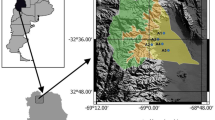Abstract
Recruitment patterns were investigated for the African honey bee in the Okavango River Delta, Botswana. The waggle dances of two observation colonies maintained in the field were monitored and used to construct maps of daily recruitment activity. These maps revealed that the African colonies frequently adjusted the allocation of recruits among food patches, recruited for 16–17 different food sites/day over areas of 55–80 km 2,and concentrated the majority of recruitment within 1 km of the hives (median foraging distances for the two colonies were 295 and 563 m). In both colonies pollen foragers were more abundant than nectar foragers, and pollen sources indicated by waggle dancers were significantly closer to the hives than nectar sources. Compared to the recruitment patterns of temperate climate colonies, the African colonies had smaller recruitment areas, smaller mean recruitment distances, and a greater emphasis on pollen foraging. These differences may be related to the contrasting survival strategies followed by tropical-versus temperate-climate honey bees.
Similar content being viewed by others
References
Danka, R., Rinderer, T., Hellmich, R., and Collins, A. (1986). Foraging population sizes of Africanized and European honey bee (Apis mellifera L.) colonies.Apidologie 17: 193–202.
Danka, R., Hellmich, R., Rinderer, T., and Collins, A. (1987). Diet-selection ecology of tropically and temporally adapted honey bees.Anim. Behav. 35: 1858–1863.
Esch, H. (1978). On the accuracy of the distance message in the dances of honey bees.J. Comp. Physiol. 123: 339–347.
Fletcher, D. (1978). The African bee,Apis mellifera adansonii, in Africa.Annu. Rev. Entomol. 23: 151–171.
Gould, J. (1982). Why do honey bees have dialects?Behav. Ecol. Sociobiol. 10: 53–56.
Gould, J., and Towne, W. (1987). Evolution of the dance language.Am. Nat. 130: 317–338.
Hamilton, W., Buskirk, R., and Buskirk, W. (1976). Defense of space and resources by Chama (Papio ursinus) baboon troops in an African desert and swamp.Ecology 57: 1264–1272.
Jaycox, E., and Parise, S. (1980). Homesite selection by Italian honey bee swarms,Apis mellifera ligustica (Hymenoptera: Apidae).J. Kans. Entomol. Soc. 53: 171–178.
Jaycox, E., and Parise, S. (1981). Homesite selection by swarms of black-bodied honeybees,Apis mellifera caucasica andA. m. carnica (Hymenoptera: Apidae).J. Kans. Entomol. Soc. 54: 697–703.
Pesante, D., Rinderer, T., and Collins, A. (1987). Differential pollen collection by Africanized and European honeybees in Venezuela.J. Apic. Res. 26: 24–29.
Rinderer, T., Bolten, A., Collins, A., and Harbo, J. (1984). Nectar-foraging characteristics of Africanized and European honeybees in the neotropics.J. Apic. Res. 23: 70–79.
Rinderer, T., Collins, A., and Tucker, K. (1985). Honey production and underlying nectar harvesting activities of Africanized and European Honeybees.J. Apic. Res. 23: 161–167.
Rinderer, T., Collins, A., Hellmich, R., and Danka, R. (1986). Regulation of the hoarding efficiency of Africanized and European honey bees.Apidologie 17: 227–232.
Ruttner, F. (1987).Biogeography and Taxonomy of Honeybees, Springer-Verlag, Berlin.
Schneider, S., and Blyther, R. (1988). The habitat and nesting biology of the African honeybee,Apis mellifera scutellata, in the Okavango River Delta, Botswana, Africa.Insectes Soc. 35: 167–181.
Schneider, S., Stamps, J., and Gary, N. (1986). The vibration dance of the honey bee. I. Communication regulating foraging on two time scales.Anim. Behav. 34: 366–385.
Seeley, T. (1985).Honeybee Ecology, Princeton University Press, Princeton, N.J.
Seeley, T. (1986). Social foraging by honeybees: How colonies allocate foragers among patches of flowers.Behav. Ecol. Sociobiol. 19: 343–354.
Seeley, T., and Visscher, P. (1985). Survival of honeybees in cold climates: The critical timing of colony growth and reproduction.Ecol. Entomol. 10: 81–88.
Smith, F. (1958). Communication and foraging range of African bees compared with that of European and Asian bees.Bee World 39: 249–252.
Visscher, P., and Seeley, T. (1982). Foraging strategy of honeybee colonies in a temperate deciduous forest.Ecology 63: 1790–1801.
von Frisch, K. (1967).The Dance Language and Orientation of Bees, Harvard University Press, Cambridge, Mass.
Winston, M. (1987).The Biology of the Honey Bee, Harvard University Press, Cambridge, Mass.
Author information
Authors and Affiliations
Rights and permissions
About this article
Cite this article
Schneider, S.S. Spatial foraging patterns of the African honey bee,Apis mellifera scutellata . J Insect Behav 2, 505–521 (1989). https://doi.org/10.1007/BF01053351
Accepted:
Issue Date:
DOI: https://doi.org/10.1007/BF01053351




